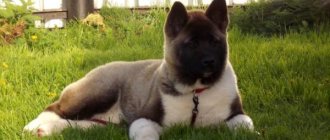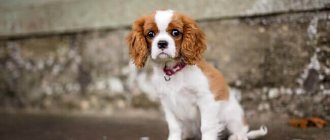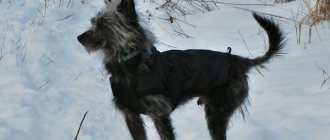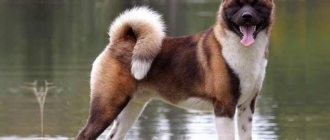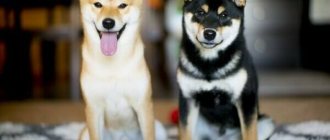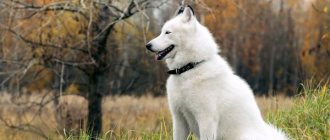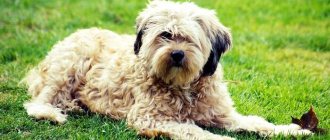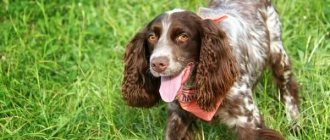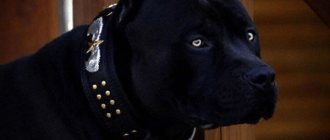Akita Inu is one of the oldest dog breeds on Earth. They gained particular popularity after the release of the film “Hachiko”, based on a real story, on television. Since then, many people have dreamed of owning this loyal, kind and very intelligent dog. Initially, Akitas served in various fields and were divided into three varieties: herding, hunting, and fighting. These days they are used mainly as companions. In the USA and Japan, they are often used in hospices to maintain a positive emotional state in sick elderly people.
A Brief History of the Akita Inu Breed
Officially, the birthplace of Akita Inu dogs is Japan, namely the small city of Akita on the island of Honshu. The history of the breed dates back to the distant 17th century, and modern Akitas owe their origin to the Matagi Inu, dogs known since the 8th century. There is also a version that Akitas originated from a Chinese Spitz dog crossed with a mastiff. There is another opinion that the ancestors of Akita dogs were Siberian Huskies crossed with Mastiffs.
It is unusual that this breed did not appear as a result of selection, but independently - dog breeds considered to be the ancestors of Akita crossed with each other without human help. In addition, the Akitu Inu is the oldest purebred breed: from about the 17th century, when the appearance of the modern Akita was finally formed, the Japanese no longer allowed its crossing with other breeds.
This is interesting! The Akita Inu is one of the 14 oldest dog breeds on the planet. Among them there are also Alaskan Malamute, Basenji, and Afghan Hound.
The name of this dog breed is translated from Japanese very simply: “Akita” is the province where they first appeared, and “inu” means dog.
At first, representatives of the breed were used by peasants as hunters and watchmen. Gradually, around the 18th century, they changed their status to “elite” and became available for purchase only to very wealthy people.
In 1927, a society for the preservation of Akita Inu was created, which was supposed to prevent the mixing of the blood of these dogs with individuals of other breeds. Later, during World War II, the breed's numbers declined sharply. Despite this, Japanese cynologists were able to preserve several purebred individuals, thanks to which the breed retained its qualities. At the end of the war, these dogs were brought by the military to Europe and America, where they became very widespread.
Features of the American Akita
The American Akita is an excellent hunter. If you suppress this natural quality in a dog, it will still manifest itself in one way or another, and not in the most pleasant way for the owner. For example, on a walk your pet will begin to rush at smaller dogs or “bully” the cat living in the same house.
The American Akita is also called a one-owner dog. She has a very hard time with a change of owner and often cannot adapt to living in another place for the rest of her life. A classic example is the famous Hachiko, an Akita Inu dog, who gained fame throughout Japan in 1932 after the publication in one of the largest Tokyo newspapers of the article “A devoted old dog awaits the return of his owner, who died seven years ago.” Based on this story, which touched the hearts of millions of people around the world, a film was made in 2009 with Richard Gere in the title role.
As you can see, the American Akita inherited this quality from its Japanese counterparts - devotion. It will be especially difficult to find common ground with an adult dog for those new owners who have not previously had experience communicating with large Molossians.
Interesting Facts
Despite the fact that the history of this breed goes back hundreds of years, every year they become more and more popular. Several interesting facts will help you learn more about the Akita Inu:
- In ancient times, the Japanese believed that Akita Inu brought good luck to the home of their owners. That is why dogs of this breed were very protected. For a long time, Japan even had a law according to which people who offended such a dog were punished very severely.
- The name of the most famous representative of this breed, a dog named Hachiko, means “eight”. In fact, the owner’s choice of such an unusual name for a pet is very simple: Hachiko was his owner’s eighth dog.
- In the United States, Akita Inus are mainly used as bodyguards. These dogs confirm their title as a bodyguard at special annual competitions. In their homeland, Japan, most representatives of the breeds take part in rescue operations.
- Akita Inus are often called smiling dogs. Thanks to the special anatomy of the mouth on their faces, a good-natured smile is almost always present.
- The Akita Inu monument to Hachiko was erected in April 1934 for the dog’s amazing devotion to his owner even after his death. Hachiko was personally present at the opening of the monument.
Training and education
Only an adult can raise and train an American Akita. Weak or elderly people should not have such a pet, since it requires a special approach.
The dog must perceive its owner as a leader. If a person cannot quickly become an authority in the eyes of the pet, then the training process will have some difficulties. An Akita will only listen to a true leader.
The animal is considered quite active. It picks up all the commands on the fly, but during the training process you need to speak loudly and clearly. The pet has high mental abilities. Before executing some commands, it may be a little slow as it considers whether it really needs to be done now.
Motivation and variety of tasks are necessary aspects of the education process. If commands are repeated often, the pet will quickly get bored. You can use various treats to train your puppy. Praise and delight from the owner will also help motivate the animal. The matured “American” will need different motivation.
At the genetic level, the Akita has a desire to be a leader, so during the training process the animal can become stubborn and refuse to follow commands. In order to quickly prevent bad behavior and subdue the pet, the owner needs to:
- place the dog with its back to the floor, holding it in this position until the resistance stops;
- Taking the pet by the withers, press it to the ground and also hold it until it stops resisting.
The methods presented are not violent. This is how the owner shows his power. The dog understands that the person is much stronger and over time accepts this. You will have to repeat these steps several times.
The American Akita must protect its owner. This is laid down at the genetic level. Despite its innate tactfulness, sometimes a dog will pay excessive attention to its authority. In order for the dog not to be on duty at the door waiting for the owner and not to sleep near his bed, it is necessary to pay great attention to the “Place!” command during the training process.
Breed description, standards and appearance
Akita Inu have characteristic features of the Japanese temperament - they are reserved and calm in unfamiliar company, but sociable and friendly among their loved ones. The appearance of representatives of this breed is very memorable: the muzzle is similar to a fox, the eyes are slanted, expressive, and the tail is curled into a ring.
Akita Inus belong to the Spitz family and are the largest dogs of this family. The height at the withers of the Akita Inu ranges from 61 to 71 cm with permissible deviations of 3 cm, both up and down. Thus, the height at the withers of male representatives of the breed is 66–71 cm, females – 61–66 cm. At the same time, Akita Inu girls have a slightly longer body than males.
The average weight of an Akita Inu as an adult is 40–50 kg: the weight of an adult male dog is usually 45–59 kg, females – 32–45 kg.
The current FCI standard, adopted back in 2001, gives the following description of the Akita Inu breed:
This is interesting! Currently, about a quarter of puppies of this breed are born with long hair. The long-haired Akita Inu differs from standard individuals by the presence of feathering on the back of the limbs, as well as elongated hair on the ears and tail. The long-haired Akita Inu is not classified as a separate variety; it is considered a defect and cannot take part in exhibitions.
Akita Inu weight by month
The age when a dog stops growing is different for each breed. The ancient Japanese Akita Inu dogs grow very slowly - their development ends only by the age of three. Akita puppies gain weight very quickly at first. Depending on the number of babies in the litter at birth, they weigh from 350 to 700 grams. Akita at 6 months already weighs 21 kg, at 10 months – 25 kg. By one year, their weight usually reaches 30 kg, and by two years – 40 kg.
This is interesting! A slowdown in the physical development of representatives of the breed occurs when their weight reaches 35 kg. From this moment and over the next 12 months, their body and head shape only changes, and their chest also grows in width.
Color
The color of the Akita Inu, according to the current standard, can be different, but it must have a clear pattern without streaks or blurs, as well as a pure color. Sometimes the color of the undercoat may not coincide with the color of the main coat - such a deviation is allowed by the standard.
This is interesting! Many Japanese dog breeds (Akita Inu, Shiba Inu, Shikoku, Hokkaido) have urajiro - white coat color in the chest area, the inside of the limbs, as well as the presence of a white mask on the face.
Akita Inu colors can be very diverse: brindle, gray, red, black. The following main types of colors of representatives of this Akita Inu breed are allowed:
It is important! The Akita Inu is not allowed to have a black mask on its face, like the American Akita.
Types of Akita Inu breed
Currently, there are two varieties of the Akita Inu dog breed - Japanese and American. The latter appeared after World War II, when US military personnel began to massively export Japanese Akita Inu puppies to their homeland. There, breeders crossed Japanese Akita Inu dogs with German shepherds and mastiffs. As a result, a new breed appeared, called the Great Japanese Dog. Later its name was changed to American Akita.
The Japanese version of the Akita Inu differs from the American Akita in that it has a more graceful build and does not have a very wide variety of colors. In addition, the American Akita has a heavy, bear-like head, and a dark mask on its muzzle. “Americans” have more pronounced fighting qualities - in case of danger, they will immediately defend the owner and his property.
This is interesting! In Russia, the American Akita is more popular than its Japanese ancestors.
Breeds Similar to Akita Inu
Currently, in the world, in addition to the Japanese Akita, the Shiba Inu is very popular - a breed of dog that is very similar in appearance to the Akita. Many inexperienced dog breeders even often confuse them. In fact, both of these breeds differ from each other not only in some external characteristics, but also in origin and character.
Shiba Inu, unlike Akita, did not live in the houses of wealthy people, but in villages and monasteries. By nature, they are more active and playful, and the main external difference between dogs of these breeds is their size. The Shiba is often called a small copy of the Akita, because its height is almost 2 times smaller than the Akita and usually does not exceed 35-40 cm. The Shiba Inu, like the Akita Inu, is perfect for keeping in a city apartment. They are also very loyal to their owners, love children and bark a little.
This is interesting! Shiba Inu are jealous of their toys - their toys symbolize prey, so you cannot take them away from these dogs. This is how their hunting instinct manifests itself. If the dog wants to play, he himself will bring the toy to the person.
Description
Appearance and photo
A large, powerful, Spitz-shaped dog with a strong, proportional build.
| Height at withers | Males from 64 to 74 cm Bitches from 58 to 64 cm. |
| Weight | Males from 32 to 39 kg Bitches from 23 to 29 kg. |
| Color |
|
| Wool | Hard and straight, with a dense undercoat. |
| Nose | Black, pigmentation is allowed only with black color. |
| Ears | Standing. |
| Language | Pink, no blue or black pigmentation. |
Wool consists of three layers. The top layer is coarse and long wool. Underneath is a layer of wool that is shorter, but just as coarse and tough. The third layer is the undercoat, a very soft and short coat. The hair on the shoulder blades and paws is longer than on other parts. The tail has the longest hair. For a purebred Akita, only three coat colors are allowed.
We invite you to look at the photos of the dogs.
Character
They are very active and require a lot of attention, which disappoints many people who dream of a calm and quiet pet. Representatives of this breed are very smart. The only drawbacks are their stubbornness and curiosity.
Due to excessive stubbornness, they are difficult to train. And with every rustle, the dog will go to its place to find out the reason. Therefore, it may seem like there is too much dog. They are willful, have leadership qualities and are very jealous. Therefore, most often the Akita does not get along with other animals, especially dogs. A well-trained Akita can tolerate its relatives, but will try with all its might to show perfection over them.
She is very reserved and not dangerous towards people. They are playful, friendly and cheerful by nature. Gets along well and enjoys playing with children.
Reference. There is evidence that Japanese aristocrats often used Akitas as nannies.
Health and life expectancy
They are distinguished by endurance and good health and immunity. Life expectancy can reach up to 15 years. But like other dogs, there are a number of diseases that are typical for this breed. Veterinarians consider congenital articular dysplasia to be the most common disease among Akitas.
They are also predisposed to diseases associated with thyroid dysfunction. For preventive purposes, it is necessary to conduct regular examinations in the clinic. Food supplements containing iodine are also considered preventive measures.
Akitas have a physiological feature called microcytosis. This means that the size of red blood cells in the blood is much smaller than in other animals. This is not considered a deviation from the norm; rather, it can be called a feature of this breed. Microcytosis does not pose any threat to the health and life of the pet.
Important! Akitas are difficult to tolerate anesthesia. This fact must be taken into account when choosing a location for operations.
The veterinary clinic must have resuscitation equipment.
Also susceptible to skin diseases such as:
- Pemphigus.
- Seborrhea.
- Dermatitis.
In terms of cleanliness, the Akita can be compared to a cat. The dog is very clean and carefully looks after its coat on its own. The owner can only comb and wash his paws after a walk. Virtually odorless. In those houses or apartments where an Akita lives there is never a smell of “dog”.
Peculiarities
The peculiarities of this breed include the fact that quiet dogs are not trimmed or cut.
This breed sheds heavily. Molting occurs twice a year for several weeks. During this period, it is recommended to comb your pet every day. It is recommended to bathe Akita 2-3 times a year only with specialized bathing products. After bathing, the coat must be dried with a hairdryer or towel.
The dog can be kept both on the street and in an apartment or house. Thanks to her warm fur coat, she is not afraid of frost. An outdoor Akita needs a spacious booth with an insulated floor. If the dog will live indoors, then it needs active walks for 1.5 - 2 hours 2-3 times a day.
Character and behavior
By nature, Akita Inu are calm and balanced dogs. They are infinitely devoted to their owners and try to follow them everywhere. These dogs are good-natured and affectionate with other family members, but only if they treat themselves well. Representatives of the breed are very curious and sociable, always trying to be aware of everything that is happening around them.
Akitas show wariness and distrust towards strangers - they will closely observe the behavior of the guest. They make good watchmen and security guards. True, they will not bite the thief, but will block their entry or exit from the house until the owner comes to the rescue. These dogs bark only in extreme cases.
It is important! Akita Inu show aggression or cruelty only in the event of an attack on himself, his owner or his property. In such a situation, they can fight with their offenders to the last drop of blood.
Representatives of the breed are usually friendly with smaller dogs and other pets. Akitas often get into fights with their relatives or other large dogs of the same sex.
Akita Inu dogs are smart, have excellent memory and quickly remember new commands. Due to natural independence and independence, problems sometimes arise with training. In this case, the owner should show patience, perseverance, exactingness and avoid rudeness and physical punishment. Training and socialization of these dogs should begin at a very early age.
Akita Inu and children
Representatives of the breed are considered one of the best nanny dogs. The Akita Inu considers the owner's children to be family, and behaves warily around other people's children. They will become good friends for children over 7 years old; it is easier for a dog to communicate with them than with kids. They usually do not show aggression in response to the clumsy treatment of young children. True, they won’t tolerate it for long either, but will simply hide in a safe place.
Basic moments
- Excellent watchdog qualities are the calling card of the American Akita. With such reliable security, you can feel calm and safe.
- By remaining faithful to the owner and recognizing his leadership, the Akita can try to dominate him. Attacks of “arrogance” most often occur during puberty.
- With proper upbringing, a representative of this breed can be molded not only into an excellent companion, but also into a hunter, guide or guard.
- The American Akita has a very stable psyche. She only shows aggression when there is danger.
- Training a breed is not easy work. The dog is extremely intelligent and unquestioningly obeys its owner only if it considers him the unconditional leader.
- The American Akita is a well-mannered dog and easily tolerates visual contact. However, if you look into her eyes, it is not recommended to bend over: she may perceive this as aggression towards herself.
- The breed does not tolerate long separation from its owner. Loneliness can trigger behavioral problems and become a source of great stress.
- Despite its open and sociable character, the Akita is quite cold with strangers until it decides for itself whether it can trust this or that person.
How to choose an Akita Inu puppy
Not everyone can afford to buy a purebred Akita Inu puppy, because the price for them is quite high and ranges from 40,000 to 70,000 rubles. There are not Japanese Akita kennels in every city, since Akita is not very popular in Russia. The largest nurseries are located in Moscow, so it will be easiest to buy an Akita Inu puppy there.
It is recommended to buy a pet of this breed only with an experienced dog handler. However, when choosing an Akita Inu puppy on your own, the future owner must pay attention to the following points:
It is important! It is recommended to purchase a pet of this breed at the age of 2–4 months. By this age, the baby will already have all the necessary documents and vaccinations. In addition, Akita Inu puppies are best trained at this age.
Character of the American Akita
The American Akita is distinguished by its independent and freedom-loving disposition. But at the same time, this is a calm dog, affectionate, balanced. Thanks to her mature, stable psyche, she behaves with dignity and shows restraint in any situation.
Representatives of the breed never have causeless reactions to external stimuli. She does not bark over trifles, and without good reason she does not rush at anything that moves, just because it moves. Akita - smart, reserved, well-mannered and noble - such behavior is completely unusual.
If you keep your pet in an ordinary city apartment, you don’t have to worry that the American Akita will cause any inconvenience to your neighbors. There will certainly be no complaints about constant barking and howling. But if an Akita starts to vocalize, you can rest assured that there is a good reason for it! The barking of your pet is a sure signal that an ill-wisher has encroached on your territory or your property.
Dogs of this breed, like real samurai, love to keep everything under their control - apparently, this is how the genes inherited from their Japanese ancestors manifest themselves. This quality in the American Akita can be called one of the fundamental, because it helps her in fulfilling the mission inherent in nature - to be an excellent watchman. Take a closer look at your dog when he surveys his possessions: there is something bewitching in his gaze, inaccessible to human understanding.
The American Akita is distinguished by its boundless devotion to its owner and his family members. Like the Cane Corso, she gets along very well with children, often even looking after them like a nanny. But, unlike the “Italian,” our “American” cannot be trusted with children who are too young. Not at all because he is capable of offending them. On the contrary, when he feels threatened, he will, without hesitation, rush to protect the little household members. An Akita cannot be a full-fledged nanny due to its size. Leaving the baby alone with her, you cannot be completely sure that the dog will not accidentally push him or cause him some kind of injury. For some of the younger family members, the Akita will become a true friend, especially for teenage children. They won't find a better companion in active games and various pranks!
At the same time, the breed is absolutely not characterized by such traits as obsessiveness and importunity. Although the Akita was specifically bred to live with humans, it still needs its own space. The “American” will never get in your way, but at the same time, you should not impose yourself on him again.
The peculiarities of the “inner world” of the breed also include intolerance to rudeness on the part of the owner and other household members. If an American Akita is yelled at or punished unfairly, she becomes very offended. Never raise your voice at your pet, do not offend him, and especially do not use physical punishment on him.
The American Akita feels great in a country house with a spacious yard. A large territory is her element: there is something to protect, and there is a place to feel like a master. When keeping a dog in an apartment, under no circumstances turn your pet into a “prisoner” of your square meters. A representative of this breed needs not only regular, but also long walks. Moreover, you need to walk him twice a day for at least 1-2 hours. Walking just “for show” is not suitable for Akita. They should be interesting, rich, active, with elements of play and training. All these points will help maintain the dog’s physical and mental health at the proper level.
The American Akita has a remarkable memory and trusts its owner, so it is very important not to deceive the dog, it does not like this and remembers such moments for the future. That is, if you, for example, lured her with a treat or gave the command “Eat!” or “Go for a walk!”, but didn’t do anything, then you risk losing your pet’s trust: he will stop perceiving you as his leader.
Quite often, a problem such as aggression towards other dogs arises in Akita behavior, which can cause some trouble for the owner. It is to dogs: she often shows loyalty to cats, but only to “her own” - there will simply be no strangers in the territory she controls. As for other people's dogs, adult Akitas, especially males, almost never accept other dogs into their company. On walks, they often show their character not from the best side, provoking quarrels and fights. From this we draw a simple conclusion: when you find yourself with your pet in dog walking areas, under no circumstances let him off the leash.
Care and maintenance
Akita Inu is an unpretentious breed of dog. Thanks to their thick undercoat, they can live outside without any problems, but Akita Inus can also be kept in an apartment. However, with the latter option, you need to provide your pet with sufficient physical activity and long walks - about 2 hours twice a day.
Caring for the coat of representatives of the breed is simple - they can be combed approximately once a week, and during periods of shedding - daily. In addition, it is recommended to give your dog special vitamin supplements at this time. Frequent bathing of the Akita is contraindicated, since the protective lubricant of the coat may be washed off. It is advisable to wash your pet no more than 1-2 times a year.
The owner also needs to ensure that plaque and tartar do not form on the pet’s teeth. This can be avoided by brushing your teeth regularly with a special toothbrush. Some dogs categorically deny this procedure - in this case, you can give your pet special bones.
Representatives of the breed also require periodic washing - the face should be wiped with a wet cloth twice a week. Ears should be cleaned once a week using a cotton pad soaked in a special solution. These dogs' nails are usually trimmed 2 times a month. In addition, to naturally wear down the claws, it is recommended to periodically walk your pet on rocky ground or asphalt.
What to feed dogs of this breed?
Japanese huskies are unpretentious eaters; they accept both natural products and ready-made food equally well. Often, owners feed the Akita according to a mixed principle: natural food and ready-made food in a 50/50 ratio.
With any choice, it is important not to forget that the pet’s diet should be varied and balanced, and it should also contain the necessary vitamins and minerals.
Natural diet
The basis of an Akita's natural diet should be:
- lean meat (rabbit, chicken, goose, turkey);
- fermented milk products (kefir, cottage cheese, fermented baked milk);
- boiled offal (hearts, liver);
- eggs;
- cereals (millet, rice, buckwheat);
- vegetables (zucchini, carrots, eggplants, pumpkin);
- fruits (apples, pears, bananas, melon).
Reference! Fruits should be included in your pet's diet only after 4 months.
The serving size depends on the dog’s weight: for every 30 kg of weight there are 400-500g of food.
When feeding your Akita natural food, it is necessary to include vitamins and minerals in its diet, which will help prevent joint problems, as well as improve the quality of the coat and the general condition of the pet.
It is necessary to control the amount of protein your dog consumes. Excess protein foods in the diet can lead to the development of allergies, dermatitis and digestive disorders.
The following foods are strictly prohibited for Akita consumption:
- sausages and smoked products;
- salty, spicy;
- any confectionery, sweets, bakery products;
- food with soy protein and chemical additives.
Ready food
Ready-made food significantly saves the owner’s time and effort, since only an experienced dog breeder can correctly determine the volume, content and proportions of the diet.
It is much easier (and without harm to the dog’s health!) to choose ready-made food. In this case, you should give preference only to high-quality products made from the most natural raw materials. The food class must be at least “premium”.
Another advantage of industrial food is the presence in its composition of the vitamin and mineral complex necessary for the dog.
The serving size depends on the weight, age and lifestyle of the pet and, as a rule, is predetermined by the manufacturer and written on the packaging.
Diet
Depending on the dog’s age, the number of feedings is determined, and the older the dog, the less often it should eat:
- up to 2 months, the puppy should eat 5-6 times a day;
- 2 months – 5 times;
- 3 months – 4 times;
- from 4 to 6 months – 3 times;
- After 6 months, the dog should be accustomed to two meals a day.
Reference! In the absence of physical activity, the Akita Inu can eat once every 2 days.
Vaccinations and susceptibility to disease
Akita Inu are considered a breed with good health. Despite this, they sometimes suffer from certain genetic diseases and may also be sensitive to certain medications. Among the “breed” diseases of the Akita Inu, the most common are:
- hip dysplasia;
- various eye diseases;
- gastric volvulus;
- thyroid diseases;
- various skin diseases.
It is mandatory to vaccinate your Akita. The first vaccination is given to the puppy against distemper and enteritis at 4 weeks. Then at 8 weeks this vaccination is repeated and the baby is additionally vaccinated against leptospirosis and hepatitis. Then at 12 weeks the dog is vaccinated against rabies. In the future, the pet is vaccinated annually with complex vaccines against rabies and other deadly infections.
It is important! 10–14 days before the first vaccination, puppies must be dewormed.
How long do Akita Inus live?
With proper care, these dogs live an average of 10-12 years. Female Akita Inus live slightly longer than males. It is true that the difference is very small - about 2 months. Before World War II, the life expectancy of the Akita Inu was longer - about 15 years, but the atomic bombing of Hiroshima and Nagasaki left its mark.
How much does an American Akita cost?
The American Akita is not widespread in Russia. It is even less common than its Japanese counterpart, the Akita Inu. But in large cities you can find nurseries for breeding these majestic beauties. There is a direct relationship between the cost of a puppy and the class to which it belongs.
- A puppy without a pedigree is relatively inexpensive, from 10,000 to 12,000 rubles. However, such savings are associated with the risk of having a non-purebred Akita or, even worse, a pet with developmental defects.
- You can purchase a pet-class puppy, due to any deviations from the breed standard, not suitable for breeding, but healthy, for 15,000 rubles.
- From 20,000 to 30,000 rubles. There are puppies with a pedigree and permission to breed, but at the same time they do not have a chance to become winners of exhibitions due to some minor deviations.
- Well, if you have your sights set on a high-breed Akita, a future winner of exhibitions and the owner of a variety of titles, then choose a show-class puppy - a descendant of titled parents. Such a baby can cost 50,000 rubles, and this price is minimal.
By choosing the right pet for yourself, you can be sure that in the future you will become a strong tandem with him, doomed to successful interaction. And over time, as you grow older, your American Akita will turn into a full-fledged member of the family - obedient and devoted.
source www.lapkins.ru
Pros and cons of the breed
Before purchasing an Akita Inu, the future owner should study all the pros and cons of this dog breed. True, looking at such charming creatures, it is difficult to believe that they could have any flaws.
The main pros and cons of the breed are presented in the table.
ProsCons
| Loyal to the owner and his family members | Stubbornness and independence |
| Balanced character | May fight with other dogs |
| Rarely bark | Fairly high cost of puppies |
| Attractive appearance | |
| Brave and Fearless | |
| Have a developed intellect | |
| They love children | |
| Does not require much effort in care and maintenance |
The Japanese dog, like other pets, needs care: necessary physical activity, long walks in the fresh air, balanced nutrition, competent training and respectful attitude. The efforts of the owner and his attitude towards the pet will be returned in double or triple size: Akita Inu have not only outstanding external data, but also a wonderful character.
Advantages and disadvantages
The American Akita dog breed has both positive and negative qualities.
The advantages of a dog include:
- devotion to the owner;
- loyalty to all family members;
- innate hunting qualities;
- excellent security potential;
- the ability to keep a dog in the apartment;
- cleanliness.
Many owners identify two main disadvantages:
- the dog's desire to be independent;
- profuse hair loss during shedding.
Are boys and girls different?
The difference in appearance between Akita Inu boys and girls is manifested mainly in size .
Thus, the height of males is 64-70 cm, and that of females is 58-64 cm.
There is also a difference in weight. The average weight of males is 40-45 kg, and females - 32-42 kg.
Owner reviews
My daughter has wanted a dog since childhood. I was against it for a long time, but in the end I gave in. The choice of breed was influenced by the film “Hachiko”. The puppy was bought from a kennel. Buran was already 2 months old. The kennel vaccinated him, branded him, and gave us a puppy passport. He immediately became the favorite of the whole family. Almost never gets sick. Flea allergies and digestive problems can occur if you eat bones or pork. When we realized this and began to monitor it closely, the problems disappeared. When Buran was six months old, he and the dog were trained by a dog handler. Now he is 4.5 years old and is a full-fledged member of the family. A true friend, smart and loyal.
Natalya Kukota Cherkessk
I love dogs very much, so for one of my birthdays I was given an Akita. I will say right away that this is an active dog that needs to be walked often, otherwise excessive energy can become a problem. Especially if you live in an apartment.
He eats quite a lot, in my opinion.
To prevent her from gnawing everything in her path, buy her more toys and special bones.
My opinion is that this breed is incredibly smart and beautiful, but not for beginners.
Tatyana, Voronezh
